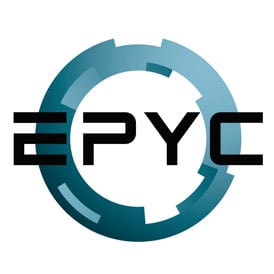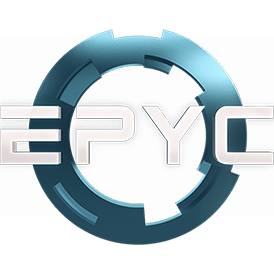Intel Celeron 440 vs AMD EPYC 7662
Last updated:
CPU comparison with benchmarks

|

|
|
| Intel Celeron 440 | AMD EPYC 7662 | |
CPU comparisonIn this CPU comparison, we compare the Intel Celeron 440 and the AMD EPYC 7662 and use benchmarks to check which processor is faster.
We compare the Intel Celeron 440 1 core processor released in Q3/2006 with the AMD EPYC 7662 which has 64 CPU cores and was introduced in Q1/2020. |
||
| Intel Celeron (165) | Family | AMD EPYC (129) |
| Intel Celeron 400 (4) | CPU group | AMD EPYC 7002 (24) |
| 1 | Generation | 2 |
| Conroe (Core) | Architecture | Rome (Zen 2) |
| Desktop / Server | Segment | Desktop / Server |
| -- | Predecessor | -- |
| -- | Successor | AMD EPYC 7763 |
|
|
||
CPU Cores and Base FrequencyThe Intel Celeron 440 is a 1 core processor with a clock frequency of 2.00 GHz. The processor can compute 1 threads at the same time. The AMD EPYC 7662 clocks with 2.00 GHz (3.30 GHz), has 64 CPU cores and can calculate 128 threads in parallel. |
||
| Intel Celeron 440 | Characteristic | AMD EPYC 7662 |
| 1 | Cores | 64 |
| 1 | Threads | 128 |
| normal | Core architecture | normal |
| No | Hyperthreading | Yes |
| No | Overclocking ? | No |
| 2.00 GHz | Frequency | 2.00 GHz |
| -- | Turbo Frequency (1 Core) | 3.30 GHz |
| -- | Turbo Frequency (All Cores) | 2.40 GHz |
Memory & PCIeUp to 16 GB of memory in a maximum of 2 memory channels is supported by the Intel Celeron 440, while the AMD EPYC 7662 supports a maximum of GB of memory with a maximum memory bandwidth of 51.2 GB/s enabled. |
||
| Intel Celeron 440 | Characteristic | AMD EPYC 7662 |
| DDR3-1066, DDR2-800 | Memory | DDR4-3200 |
| 16 GB | Max. Memory | |
| 2 (Dual Channel) | Memory channels | 8 (Octa Channel) |
| 17.1 GB/s | Max. Bandwidth | 51.2 GB/s |
| No | ECC | Yes |
| 0.50 MB | L2 Cache | -- |
| -- | L3 Cache | 256.00 MB |
| -- | PCIe version | 4.0 |
| -- | PCIe lanes | 128 |
| -- | PCIe Bandwidth | 252.0 GB/s |
Thermal ManagementThe Intel Celeron 440 has a TDP of 35 W. The TDP of the AMD EPYC 7662 is 225 W. System integrators use the TDP of the processor as a guide when dimensioning the cooling solution. |
||
| Intel Celeron 440 | Characteristic | AMD EPYC 7662 |
| 35 W | TDP (PL1 / PBP) | 225 W |
| -- | TDP (PL2) | -- |
| -- | TDP up | -- |
| -- | TDP down | -- |
| -- | Tjunction max. | -- |
Technical detailsThe Intel Celeron 440 has 0.50 MB cache and is manufactured in 65 nm. The cache of AMD EPYC 7662 is at 256.00 MB. The processor is manufactured in 7 nm. |
||
| Intel Celeron 440 | Characteristic | AMD EPYC 7662 |
| 65 nm | Technology | 7 nm |
| Monolithic | Chip design | Chiplet |
| x86-64 (64 bit) | Instruction set (ISA) | x86-64 (64 bit) |
| MMX, SSE, SSE2, SSE3 | ISA extensions | SSE4a, SSE4.1, SSE4.2, AVX2, FMA3 |
| LGA 775 | Socket | SP3 |
| None | Virtualization | AMD-V, SVM |
| No | AES-NI | Yes |
| Windows 10, Linux | Operating systems | Windows 10, Linux |
| Q3/2006 | Release date | Q1/2020 |
| -- | Release price | -- |
| show more data | show more data | |
Rate these processors
Average performance in benchmarks
⌀ Single core performance in 1 CPU benchmarks
⌀ Multi core performance in 2 CPU benchmarks
Geekbench 5, 64bit (Single-Core)
Geekbench 5 is a cross plattform benchmark that heavily uses the systems memory. A fast memory will push the result a lot. The single-core test only uses one CPU core, the amount of cores or hyperthreading ability doesn't count.
|
|
Intel Celeron 440
1C 1T @ 2.00 GHz |
||
|
|
AMD EPYC 7662
64C 128T @ 3.30 GHz |
||
Geekbench 5, 64bit (Multi-Core)
Geekbench 5 is a cross plattform benchmark that heavily uses the systems memory. A fast memory will push the result a lot. The multi-core test involves all CPU cores and taks a big advantage of hyperthreading.
|
|
Intel Celeron 440
1C 1T @ 2.00 GHz |
||
|
|
AMD EPYC 7662
64C 128T @ 2.40 GHz |
||
Estimated results for PassMark CPU Mark
Some of the CPUs listed below have been benchmarked by CPU-monkey. However the majority of CPUs have not been tested and the results have been estimated by a CPU-monkey’s secret proprietary formula. As such they do not accurately reflect the actual Passmark CPU mark values and are not endorsed by PassMark Software Pty Ltd.
|
|
Intel Celeron 440
1C 1T @ 2.00 GHz |
||
|
|
AMD EPYC 7662
64C 128T @ 2.40 GHz |
||
Cinebench R20 (Single-Core)
Cinebench R20 is the successor of Cinebench R15 and is also based on the Cinema 4 Suite. Cinema 4 is a worldwide used software to create 3D forms. The single-core test only uses one CPU core, the amount of cores or hyperthreading ability doesn't count.
|
|
Intel Celeron 440
1C 1T @ 2.00 GHz |
||
|
|
AMD EPYC 7662
64C 128T @ 3.30 GHz |
||
Cinebench R20 (Multi-Core)
Cinebench R20 is the successor of Cinebench R15 and is also based on the Cinema 4 Suite. Cinema 4 is a worldwide used software to create 3D forms. The multi-core test involves all CPU cores and taks a big advantage of hyperthreading.
|
|
Intel Celeron 440
1C 1T @ 2.00 GHz |
||
|
|
AMD EPYC 7662
64C 128T @ 2.40 GHz |
||
Devices using this processor |
|
| Intel Celeron 440 | AMD EPYC 7662 |
| Unknown | Unknown |
Popular comparisons containing this CPUs
back to index

